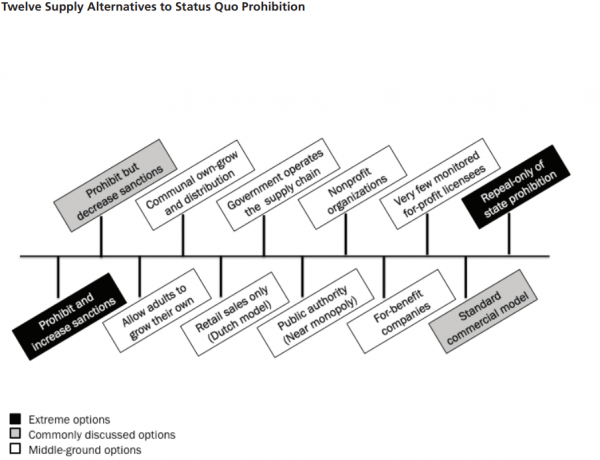
Marijuana legalization is about to have another big election.
In November’s midterm elections, voters in Michigan and North Dakota will vote on ballot initiatives that would legalize cannabis for recreational purposes in those states. And voters in Utah and Missouri will vote on medical marijuana.
The ballot initiatives could continue momentum for marijuana legalization — during what’s already been a huge year for legal pot. This year, California opened the world’s biggest legal marijuana market, Vermont legalized marijuana possession (becoming the first state to do so through its legislature), and Canada became the world’s first wealthy nation to fully legalize pot.
Marijuana is legal for recreational and medical use in nine states. It’s legal only for medical purposes in 21 more states.
Voters in November will have a chance to expand that map. Here’s what the major statewide ballot initiatives would do.
Marijuana legalization in Michigan
Michigan Proposal 1 is, by and large, a standard marijuana legalization initiative. Its big aims:
- Allows people 21 and older to possess, use, and buy marijuana for recreational use.
- Lets individuals grow up to 12 marijuana plants in their homes for personal consumption.
- Sets up a system through which the state government can license and regulate marijuana businesses, from growers to retail outlets.
- Imposes a 10 percent sales tax on marijuana, with revenue dedicated to implementation of the initiative, clinical research, education, infrastructure, and municipalities with marijuana businesses.
- Enables local and municipal governments to ban or restrict marijuana businesses.
Medical marijuana is already legal in Michigan, so the initiative would have limited impact in that area.
So far, the proposal is polling well. According to Ballotpedia’s tracker, every public poll has found that a plurality or majority of voters support the initiative.
Marijuana legalization in North Dakota
North Dakota Measure 3 takes a different approach to legalization than the initiatives that have been so successful so far. Its major changes:
- Allows people 21 and older to possess, use, grow, buy, and sell marijuana for recreational purposes.
- Creates penalties for people under 21 possessing or attempting to distribute marijuana, and for people distributing marijuana to others who are under 21.
- Expunges previous marijuana convictions from criminal records.
That’s it. There’s no language about regulation or taxes.
Cole Haymond, an adviser for the campaign, told Christopher Ingraham at the Washington Post that this is by design: “We leave our bill wide open so the legislature can do their job — regulations, taxes, zoning, whatever.”
This is not how previous successful ballot initiatives worked. They left a lot of room for state lawmakers and regulators to flesh out a system under which marijuana can be bought and sold, but the initiatives generally set up a framework that these policymakers had to follow. North Dakota, at least, is taking a different approach — and it will be interesting to see what, if anything, state officials come up with.
Medical marijuana is already legal in North Dakota, so the ballot measure would have no significant impact in that area.
Public polling on the measure is limited and mixed. According to Ballotpedia’s tracker, one poll in February found plurality support, but another in August found majority opposition. It would be surprising if deep-red North Dakota legalized marijuana before more liberal states like New York and New Jersey, but the limited polling suggests it’s not impossible.
Medical marijuana legalization in Utah
Utah Proposition 2 is mostly a standard medical marijuana legalization initiative. The big points:
- Allows patients to obtain medical marijuana cards via a doctor’s office for certain qualifying conditions, such as HIV/AIDS, cancer, chronic pain (if someone is at risk for opioid painkiller addiction or overdose), and multiple sclerosis. (The medical use of pot for pain and multiple sclerosis is supported by some research, but other areas need more study.)
- Maintains a prohibition on smoking marijuana, instead allowing vaping, edibles, and other means of consuming marijuana.
- Imposes some restrictions on doctors, including prohibitions on owning or working for a medical marijuana dispensary and on recommending a card to more than 20 percent of their patients.
- Creates a system through which state officials will license and regulate medical marijuana businesses, from growers to dispensaries.
- Allows growing up to six pot plants for personal medical use, but only if a patient lives more than 100 miles from a licensed dispensary.
There’s a twist: In the lead-up to the election, Utah advocates, policymakers, and other stakeholders agreed to compromise legislation that will change how medical cannabis is actually implemented. The compromise agreement will need approval from the legislature and governor, but lawmakers appear poised to pass it, especially if voters okay Proposition 2.
Ben Lockhart at Deseret News has a great breakdown of the compromise. But here are the big changes:
- Removes some qualifying conditions, including autoimmune disorders, but adds others, such as receiving hospice care.
- Requires doctors to get training to be able to recommend medical marijuana cards.
- Gives municipal governments more room to prohibit medical marijuana dispensaries.
- Imposes new rules on medical marijuana dispensaries, including that they each have a licensed pharmacist, and calls them “pharmacies.”
- Doesn’t allow growing marijuana for personal medical use.
- Bans marijuana edibles (on top of smoking), but allows other means of consumption.
Utah Gov. Gary Herbert (R) said he will hold a special session to pass the compromise agreement, regardless of whether voters approve Proposition 2. The compromise has powerful Utah advocates behind it, including the Mormon church. Whether it actually passes the legislature, though, remains to be seen.
Proposition 2, meanwhile, has strong support in Utah. According to Ballotpedia’s tracker, polls have consistently found that more than 60 percent of surveyed Utahns support the initiative. This helps explain why the legislature might act: If they don’t, medical marijuana seems likely to be legalized anyway — under terms more conservative lawmakers don’t want.
Medical marijuana legalization in Missouri
Missouri will have three different ballot initiatives dedicated to legalizing medical marijuana. All of the initiatives would legalize possessing, using, buying, and selling pot for medicinal purposes, and allow the state to license and regulate dispensaries through a new system.
But there are some differences on taxes:
- Amendment 2 would impose a 4 percent tax on marijuana sales, and the funds would be mainly used to pay for services for military veterans.
- Amendment 3 would impose a 15 percent tax on marijuana sales as well as additional taxes in other areas of production and sales, with the revenue primarily dedicated to a research institute that will try to find cures and treatments for cancers and other medical conditions.
- Proposition C would impose a 2 percent tax on marijuana sales, and the revenue would be set for veterans’ services, drug treatment, early childhood education, and public safety.
There are also some differences with qualifying conditions. If a patient doesn’t have a qualifying condition under the law, Amendment 2 and Proposition C still let the patient get permission to use medical marijuana with a doctor’s approval. Amendment 3, meanwhile, is more limiting — only letting patients petition a board to get a condition added to the state’s list.
And Amendment 2 allows home growing, while the other two measures do not.
For more information, Ballotpedia has a thorough breakdown of the initiatives’ differences.
The face-off between three medical marijuana initiatives is bizarre, created by disagreements over what Missouri’s medical marijuana program should look like.
So what happens if they all pass? As Will Schmitt at the Springfield News-Leader wrote, Missouri law does actually provide some clarity here. First, the constitutional amendments would take priority, leaving Proposition C in the dark if all three initiatives pass. Second, the initiative with more votes would take precedence, so it may come down to which initiative can get more support.
A poll from August found that medical marijuana has majority support in Missouri. But it’s only one poll, and it’s unclear how majority support will ultimately translate to a ballot with three different initiatives.
Marijuana is already legal for recreational use in nine states
Based on the Marijuana Policy Project’s count, 30 states have already legalized medical marijuana, and nine have legalized cannabis for recreational uses (to varying degrees).
Generally, not many people deny that at least some of the components of marijuana can help with some medical conditions. The debate around medical marijuana is mostly about the details of how states implement medical marijuana — particularly about whether a state system is too lax (creating de facto legalization), and whether it would be better to take the specific components of marijuana through the federal approval process for other medicines instead of legalizing the whole plant for medicinal use through a voter initiative.
Public discussion about recreational legalization is, generally, more binary.
Supporters of legalization argue that it eliminates the harms of marijuana prohibition: the hundreds of thousands of arrests around the US, the racial disparities behind those arrests, and the billions of dollars that flow from the black market for illicit marijuana to drug cartels that then use the money for violent operations around the world. All of this, legalization advocates say, will outweigh any of the potential downsides — such as increased cannabis use — that might come with legalization.
Opponents, meanwhile, claim that legalization will enable a huge marijuana industry that will market the drug irresponsibly. They point to America’s experiences with the alcohol and tobacco industries, which have built their financial empires in large part on some of the heaviest consumers of their products. This could result in far more people using pot, even if it leads to negative health consequences.
It’s worth noting, though, that legalization doesn’t have to be so binary. Although most states that have legalized have adopted a model that lets for-profit companies produce, sell, and market the drug (similar to alcohol), policy experts argue that there are more options.
The government could legalize possession and gifting but not sales, as Washington, DC, has done. It could put state agencies in charge of selling pot, as some provinces in Canada are doing (which research has linked to better public health outcomes for alcohol). A RAND report, in fact, noted that there are at least a dozen alternatives to standard prohibition.

Again, though, only prohibition and the standard commercial model have gotten a lot of discussion in policy debates. That’s essentially what’s on the ballot in Michigan.
But that may be changing. As more state legislatures get involved in marijuana legalization (including potentially North Dakota, since the ballot initiative is so vague that it may force lawmakers to act), they could consider a broader array of options — ones that are more tuned to public health and safety concerns. But that will require more legislative work than what’s currently on the ballot for 2018.
Sourse: breakingnews.ie
0.00 (0%) 0 votes


































